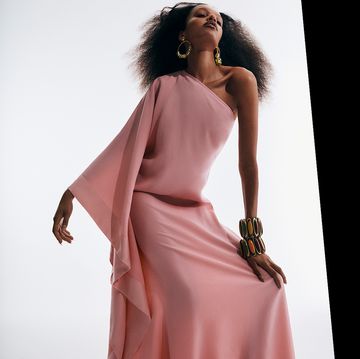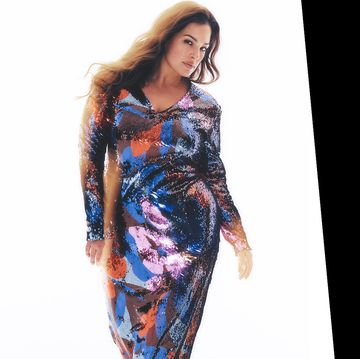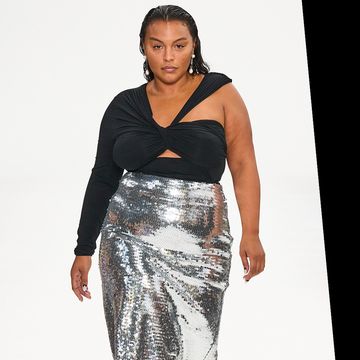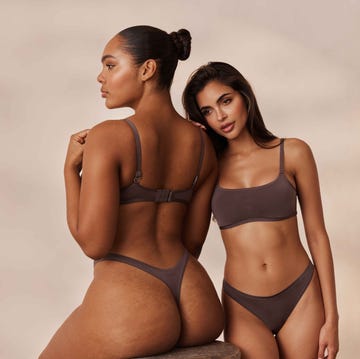What will it take for fashion to become a more size-inclusive industry, from runway to shop floor? ELLE UK shines a light on the designers, models and advocates reimagining the body in fashion and pushing for a more size-inclusive industry for all.
Michaela Stark’s designs start with her own body. She contorts curves, including her own, using custom-made corsets and couture creations. Her practice began with that most maligned of mediums: the selfie. Playing with her body, pushing and pulling the flesh into new, unseen shapes, she saw the potential for a body of work.
Born in Brisbane and based in London, Stark’s garments are designed to simultaneously alter the shape of the wearer’s body and the viewer’s perception of their own standards of beauty.
'I've come to understand that what I'm doing is playing with [these] ideas,' says Stark, at her studio in Hackney. 'In my opinion, if you throw something in front of people that is challenging, people have to consider what is beautiful and what is ugly. If it doesn't have ties to what people know as beautiful, they're less likely to open their minds to it.'
In the past, she’s made garments entitled the ‘Skinny Sag Dress’ and ‘Fat Roll Jumpsuit’ and this playfulness is key to everything she creates, combining a mixture of innocent dress-up and sensual undress.
This exploration of the binary within beauty is focused around femininity. Stark’s recent collection features corsetry, tulle, suspenders and accessories, like bows for the hair and ribbons that run from toe to hip. Her pieces manipulate the body in ways traditional beauty standards deem ungainly; ripples appear in flesh, bulges are exposed from tight ribbons and sculpted boning.
Her use of colour and texture is bang on trend - the pastels and frills perfectly align with TikTok’s interest in the ‘coquette aesthetic’ - but Stark explains that many people in the fashion industry have told her that her work doesn’t fit: 'They think sculpting the body isn't a commercial proposition.'
Of course, Stark's work is clearly artistic. More often than not, Stark is her own model, using herself as muse for her body-morphing craft. Early Instagram posts see her breasts pushed up against glass à la Jenny Saville. In 2022, image-maker Nick Knight 3D-scanned Stark and two of her regular models, Dodo Potato and Jade O’Belle, for a sculpture celebrating the contemporaneity of voluptuous bodies at Photo London. Stark stars in the lookbook for her spring/summer 2023 collection in a series of portraits with distinctly John Currin-esque curves and colours.
Nonetheless, Stark considers herself a fashion designer; she trained as a seamstress, cut her teeth working on Beyoncé’s tour costumes and aims to stage runway shows, or at least immersive performances to show her work. She looks to her London contemporaries Di Petsa and Sinéad O’Dwyer in this sense, women who celebrate women in all their diversities and extremities. In 2021, she collaborated with Jean Paul Gaultier on a performance in Paris with his archival pieces.
In many ways, the artistic nature of her practice with its distinct message harks back to early McQueen or she who Stark refers to as 'the queen', the late, great Vivienne Westwood.
Regularly posting herself in her own designs, Stark is no stranger to the backlash bigger bodies can receive online, particularly in a state of - shock, horror - undress. She views this as an important part of the process, confronting people with their own fears or body dysmorphia and has kept messages where she’s even seen viewers change their minds. Stark pulls up an Instagram direct message that expresses disgust at a visual she has posted, before the individual behind the account comes full circle and thanks the designer, calling her work ‘beautiful’.
'I think people find it so challenging [if they] aren't already in this world of body acceptance,' she muses. 'It challenges them, and then they get confused why they might find it beautiful. Either their reaction is to investigate it more and accept it, or to get really angry about it. But I don't think that those same conversations could be had if it didn't, in a way, confuse people.'
A Michaela Stark silhouette celebrates a cinched-in waist - a popular shape since the sixteenth century - but also asymmetric breasts, hanging heavy and proud, and skirts that highlight the dipped curve of a belly. 'This shape is a motif, in a way,' she explains, 'because it’s my shape. But if I create a couture piece for a client, I think of their shape and how they’d want to be celebrated.'
Showing a pair of olive green bloomers in a gauzy chiffon, Stark explains how the elastic won’t cut into the skin but gives a new shape to the hips. Pieces like these also consider the trans feminine body, giving space where cis-only designs might not.
'I think there's this thing about body acceptance,' Stark considers, 'where a lot of the time, people who are able to reach [it] are the people who've really struggled with physical hatred of their own body.' In her presentation of self as well as her consideration of others, Stark’s practice truly feels like an evolution of acceptance; through play, through wit and through a reconsideration of beauty.














